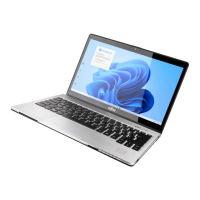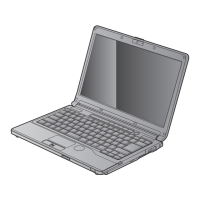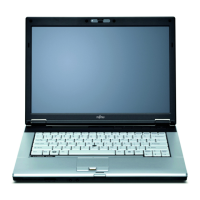
Do you have a question about the Fujitsu Lifebook S935 and is the answer not in the manual?
| Form factor | Clamshell |
|---|---|
| Product type | Laptop |
| Product color | Black, Silver |
| Housing material | Aluminium, Magnesium |
| Memory slots | 1x SO-DIMM |
| Internal memory | 8 GB |
| Memory clock speed | 1600 MHz |
| Memory form factor | On-board + SO-DIMM |
| Internal memory type | DDR3L-SDRAM |
| Maximum internal memory | 12 GB |
| Memory layout (slots x size) | 2 x 4 GB |
| SSD capacity | The Solid State Drive's storage capacity in Gigabytes. |
| SSD interface | SATA III |
| Storage media | SSD |
| Optical drive type | DVD Super Multi |
| Card reader integrated | Yes |
| Total storage capacity | 256 GB |
| Compatible memory cards | SD, SDHC, SDXC |
| Number of SSDs installed | 1 |
| Display diagonal | 13.3 \ |
| Display brightness | 330 cd/m² |
| Native aspect ratio | 16:9 |
| On-board graphics card ID | 0x1616 |
| Discrete graphics card model | Not available |
| On-board graphics card model | Intel® HD Graphics 5500 |
| On-board graphics card family | Intel® HD Graphics |
| Maximum on-board graphics card memory | 16 GB |
| On-board graphics card OpenGL version | 4.3 |
| On-board graphics card base frequency | 300 MHz |
| On-board graphics card DirectX version | 11.2 |
| On-board graphics card dynamic frequency (max) | 900 MHz |
| Audio system | Realtek ALC283 |
| Number of built-in speakers | 2 |
| Wi-Fi standards | Wi-Fi 5 (802.11ac) |
| Bluetooth version | 4.0 |
| Ethernet LAN data rates | 10, 100, 1000 Mbit/s |
| Charging port type | DC-in jack |
| USB 2.0 ports quantity | 0 |
| USB 3.2 Gen 1 (3.1 Gen 1) Type-A ports quantity | 3 |
| Pointing device | Touchpad |
| Keyboard number of keys | 85 |
| Recovery operating system | Windows 10 Pro |
| Operating system installed | Windows 7 Professional |
| Operating system architecture | 64-bit |
| Battery capacity | 7100 mAh |
| Number of battery cells | 6 |
| AC adapter frequency | 50 - 60 Hz |
| AC adapter input voltage | 100 - 240 V |
| AC adapter output voltage | 19 V |
| Cable lock slot type | Kensington |
| Password protection type | BIOS, HDD, Supervisor, User |
| Operating temperature (T-T) | 5 - 35 °C |
| Operating relative humidity (H-H) | 20 - 85 % |
| Sustainability certificates | RoHS, EPEAT Gold, ENERGY STAR |
| Certification | WEEE, CE, CB, Microsoft Operating Systems (HCT / HCL entry / WHQL) |
| Tcase | - °C |
| Bus type | DMI2 |
| Stepping | F0 |
| Tjunction | 105 °C |
| Processor cache | 3 MB |
| Processor model | i5-5300U |
| System bus rate | 5 GT/s |
| Processor family | Intel® Core™ i5 |
| Processor series | Intel® Core™ i5-5300 Mobile Series |
| Processor socket | BGA 1168 |
| Processor threads | 4 |
| Processor codename | Broadwell |
| Number of QPI links | - |
| Processor frequency | 2.3 GHz |
| Processor cache type | L3 |
| Configurable TDP-down | 7.5 W |
| Processor lithography | 14 nm |
| Processor manufacturer | Intel |
| Processor front side bus | - MHz |
| PCI Express slots version | 2.0 |
| Processor boost frequency | 2.9 GHz |
| Processor operating modes | 32-bit, 64-bit |
| PCI Express configurations | 4x1, 2x4 |
| Thermal Design Power (TDP) | 15 W |
| Configurable TDP-down frequency | 0.6 GHz |
| Maximum number of PCI Express lanes | 12 |
| Processor code | SR23X |
| Processor ARK ID | 85213 |
| Processor package size | 40 x 24 x 1.3 mm |
| Supported instruction sets | AVX 2.0 |
| Intel Identity Protection Technology version | 1.00 |
| Depth | 215 mm |
|---|---|
| Width | 319 mm |
| Height | 26.5 mm |
| Weight | 1370 g |
Highlights the advanced features and design of the notebook.
Provides links to drivers, updates, and support resources online.
Explains symbols, font styles, and text formatting used in the manual.
An overview of the notebook's hardware components and connections.
Details the layout and function of front-facing ports and LEDs.
Describes the various input/output ports located on the notebook's sides.
Outlines ports and access panels found on the notebook's underside.
Essential safety and operational information for notebook users.
Essential safety information and warnings for notebook usage.
Specific safety precautions for using radio components like Wi-Fi and Bluetooth.
Tips for conserving power and guidelines for transporting the device.
Guidelines for safely moving and cleaning the notebook.
Initial setup and configuration steps for new users.
Steps for unpacking the device and verifying its condition.
Guidance on selecting a suitable operating location and connecting the power adapter.
Step-by-step instructions for the first time powering on the notebook.
Basic operations, features, and user interface elements of the notebook.
Explains the meaning of LED indicators and the function of buttons.
Procedures for turning the notebook on and off correctly.
How to use the keyboard, including special keys and functions.
Using the integrated numeric keypad for data entry.
Explains the use of function key combinations for various tasks.
Operating the touchpad for cursor control and using the touchscreen interface.
Instructions for using the built-in webcam and connecting audio peripherals.
Information on battery life, charging, and maintenance.
Guidelines for optimal battery performance and longevity.
Step-by-step procedures for replacing the notebook's battery.
Information on interchangeable modules and optical drives.
How to swap components in the module bay.
Using the CD/DVD drive and handling data media.
How to configure settings to optimize power consumption and battery life.
Instructions for using memory cards and SIM cards.
Managing wireless connections and setting up network access.
Enabling/disabling Wi-Fi, Bluetooth, and other wireless features.
Steps for configuring wired (LAN) and wireless network access.
Description of the optional port replicator and its capabilities.
Detailed layout and function of all ports on the port replicator.
How to connect and disconnect the notebook from the port replicator.
Instructions for connecting various peripherals to the notebook.
How to connect external displays via VGA, DisplayPort, DVI, or HDMI.
Connecting devices using HDMI, USB, and audio ports.
Features to protect the system from unauthorized access.
Configuring fingerprint and palm vein sensors for authentication.
Using physical locks and setting passwords for security.
Securing BIOS settings and the hard disk with passwords.
Enabling/disabling TPM and using SmartCards for security.
Guidelines for internal maintenance and component replacement.
General precautions for handling internal parts and replacing memory.
How to access and change system settings in the BIOS.
Step-by-step instructions for using the BIOS Setup Utility.
Solutions for frequently encountered problems and error messages.
Resolving issues with booting, screen output, and network connections.
Addressing error messages, acoustic signals, and SmartCard-related problems.
Detailed technical information about the notebook's hardware.
Key technical details including dimensions, memory, and operating conditions.
Important legal, regulatory, and warranty information.
Compliance statements, country-specific regulations, and FCC/CE notices.











